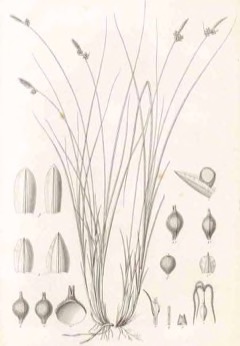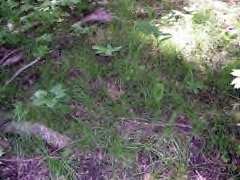 |
|
edibleplants.org |
 |
| Jay Sturner wikimedia.org |
Translate this page:
Summary
Physical Characteristics

 Carex pensylvanica is an evergreen Perennial growing to 0.3 m (1ft) by 0.5 m (1ft 8in) at a medium rate.
Carex pensylvanica is an evergreen Perennial growing to 0.3 m (1ft) by 0.5 m (1ft 8in) at a medium rate.
See above for USDA hardiness. It is hardy to UK zone 3. The flowers are pollinated by Wind, Insects.
It is noted for attracting wildlife.
Suitable for: light (sandy), medium (loamy) and heavy (clay) soils and prefers well-drained soil. Suitable pH: mildly acid and neutral soils and can grow in very acid soils.
It can grow in full shade (deep woodland) semi-shade (light woodland) or no shade. It prefers dry or moist soil and can tolerate drought.
UK Hardiness Map
US Hardiness Map
Synonyms
C. pensylvanica var. glumabunda Peck. C. p. var. marginata (Willd.) Dewey. C. p. var. vespertina L.H.Bailey. C. marginata Willd. C. stolonifera Schwein.
Plant Habitats
Edible Uses
References More on Edible Uses
Medicinal Uses
Plants For A Future can not take any responsibility for any adverse effects from the use of plants. Always seek advice from a professional before using a plant medicinally.
None known
References More on Medicinal Uses
The Bookshop: Edible Plant Books
Our Latest books on Perennial Plants For Food Forests and Permaculture Gardens in paperback or digital formats.

Edible Tropical Plants
Food Forest Plants for Hotter Conditions: 250+ Plants For Tropical Food Forests & Permaculture Gardens.
More

Edible Temperate Plants
Plants for Your Food Forest: 500 Plants for Temperate Food Forests & Permaculture Gardens.
More

More Books
PFAF have eight books available in paperback and digital formats. Browse the shop for more information.
Shop Now
Other Uses
Soil stabilization
Capable of colonizing disturbed sites [277]. Groundcover for dry shade. Underplanting for shade perennials. Lawn substitute for dry soils in shady areas (forms a turf that never needs mowing or mow 2-3 times per year to 2" tall). [368-1]. Provides cover for migratory fowl, sandhill cranes, and ducks (who also use the leaves for nesting material). It is also used by sharptail grouse and prairie chickens for nesting, cover, and dancing grounds [277]. Erosion Control. Ornamental: The leaves are soft and fine textured with an arching habit. It can be used as a lawn substitute [368-1]. Tolerant of mowing. Moderate salt tolerance.
Special Uses
Attracts Wildlife Food Forest Ground Cover
References More on Other Uses
Cultivation details
Easily grown in average, dry to medium, well-drained soils in part shade to full shade. Prefers loose loams in dry soils in sun-dappled part shade. Most sedges prefer moist to wet soils, but not this one. Plants spread by rhizomes. Plants may self-seed in optimum growing conditions[368-1]. Soil pH: 4.0 - 8.0. Drought: Tolerant. Flood: Moderate. Salt: Moderate. Soil Compaction: Intolerant. Mowing: Tolerant. Does not compete well with larger plants in full sun. Competes well in moderate to deep shade. Can form dense mats. Makes one of the earliest spring appearances of the Carices. Life Span:Long-Lived Perennial. Stand Persistence:Long. Form: Clump. [368-1]. For polyculture design as well as the above-ground architecture (form - tree, shrub etc. and size shown above) information on the habit and root pattern is also useful and given here if available. The plant growth habit is a clumper with limited spread [1-2]. An evergreen. In garden design, as well as the above-ground architecture of a plant, root structure considerations help in choosing plants that work together for their optimal soil requirements including nutrients and water. The root pattern is clumping, giving the plant a clumping habit. The predictable growth behaviour makes it easier to maintain without having to apply containment methods[2-1].
References Carbon Farming Information and Carbon Sequestration Information
Temperature Converter
Type a value in the Celsius field to convert the value to Fahrenheit:
Fahrenheit:
The PFAF Bookshop
Plants For A Future have a number of books available in paperback and digital form. Book titles include Edible Plants, Edible Perennials, Edible Trees,Edible Shrubs, Woodland Gardening, and Temperate Food Forest Plants. Our new book is Food Forest Plants For Hotter Conditions (Tropical and Sub-Tropical).
Shop Now
Plant Propagation
Plants spread by rhizomes. Plants may self-seed in optimum growing conditions. This species often does not grow well from seed.[368-1].
Other Names
If available other names are mentioned here
Pennsylvania sedge, Penn sedge.Early sedge, Common oak sedge, Yellow sedge, Oak Sedge.
Native Range
NORTHERN AMERICA: Canada, Québec, Ontario, Manitoba, United States, Connecticut, Indiana, Maine, Massachusetts, Michigan, New Hampshire, New Jersey, New York, Ohio, Pennsylvania, Rhode Island, Vermont, West Virginia, Illinois, Iowa, Minnesota, Missouri, South Dakota, Wisconsin, Arkansas, Delaware, Georgia, Kentucky, Maryland, North Carolina, Tennessee, Virginia,
Weed Potential
Right plant wrong place. We are currently updating this section.
Please note that a plant may be invasive in one area but may not in your area so it's worth checking.
None Known
Conservation Status
IUCN Red List of Threatened Plants Status :

Growth: S = slow M = medium F = fast. Soil: L = light (sandy) M = medium H = heavy (clay). pH: A = acid N = neutral B = basic (alkaline). Shade: F = full shade S = semi-shade N = no shade. Moisture: D = dry M = Moist We = wet Wa = water.
Now available:
Food Forest Plants for Mediterranean Conditions
350+ Perennial Plants For Mediterranean and Drier Food Forests and Permaculture Gardens.
[Paperback and eBook]
This is the third in Plants For A Future's series of plant guides for food forests tailored to
specific climate zones. Following volumes on temperate and tropical ecosystems, this book focuses
on species suited to Mediterranean conditions—regions with hot, dry summers and cool, wet winters,
often facing the added challenge of climate change.
Read More
Expert comment
Author
Lam.
Botanical References
Links / References
For a list of references used on this page please go here
Readers comment
| Add a comment |
|
If you have important information about this plant that may help other users please add a comment or link below. Only comments or links that are felt to be directly relevant to a plant will be included. If you think a comment/link or information contained on this page is inaccurate or misleading we would welcome your feedback at [email protected]. If you have questions about a plant please use the Forum on this website as we do not have the resources to answer questions ourselves.
* Please note: the comments by website users are not necessarily those held by PFAF and may give misleading or inaccurate information.
To leave a comment please Register or login here All comments need to be approved so will not appear immediately.
|
Subject : Carex pensylvanica
|
|
|
|